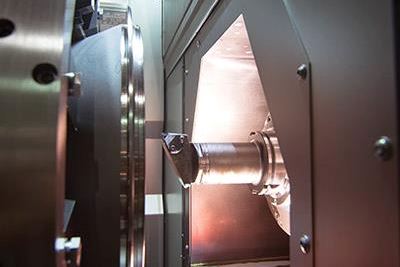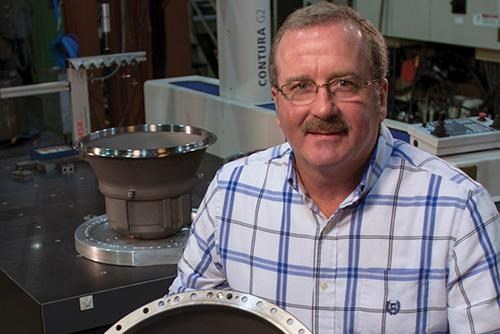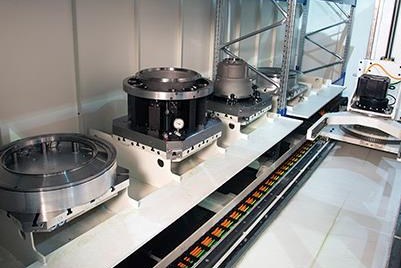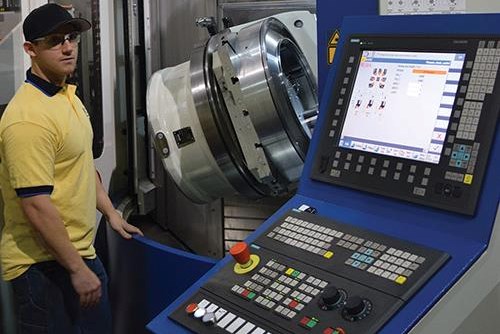The Benefits of Horizontal Turning on a Mill-Turn Machine
A mill-turn machine that can rotate a large, bell-shaped workpiece in a horizontal orientation enabled this manufacturer to hit tight tolerance and cost targets. Minimizing non-value-added time and running lights out were also essential for success.
Share




Takumi USA
Featured Content
View More


Hwacheon Machinery America, Inc.
Featured Content
View More.png;maxWidth=45)
DMG MORI - Cincinnati
Featured Content
View More
At Stein Seal in Kulpsville, Pennsylvania, the nickname for the part is simply the “bell.” It is appropriate because this titanium bearing mount and seal support is shaped very much like a bell. Approximately 12 inches tall and 18 inches in diameter at the mouth, this aerospace component has a number of critical features deep within the closed end of the cavity, including bearing contact surfaces and undercuts. Tolerances on these features are ±0.0005 inch. These tight tolerances are necessary because these features interface with a precision bearing essential to the part’s function.
“When the customer first approached us about making this part, we assured them that we could. It was certainly within our technical capabilities,” says Gary Schuler, manufacturing manager at Stein Seal. The complexity and precision of the part were in keeping with the aerospace engine seals that are the company’s main business. However, when this customer explained that the multi-year contract for the part had to meet a certain price point per piece, Mr. Schuler wasn’t so sure.
The initial process plan involved about 40 hours of processing time on vertical turn-mill machines. Only about 20 hours of that total time represented metal-removal operations. Because this plan required a sequence of cutting, probing, compensating the program and recutting, the non-machining time was substantial. Multiple fixturing and locating routines added to the time that did not add value to the part.
Nevertheless, Stein Seal agreed to put the bell into production as it sought manufacturing methods that would reduce the non-value time and streamline the metalcutting operations. The company was about to invest in several new vertical turn-mills that would be dedicated to this part when Scott Thomas, a sales engineer for Jones Kinden Co., a machinery dealer in nearby West Chester, Pennsylvania, showed Mr. Schuler and his team a brochure featuring a machine the likes of which they had not seen before. Jones Kinden had recently become a representative of GROB Systems in Bluffton, Ohio. Grob, a machine tool builder based in Germany and a major supplier of large, automated machining and assembly systems for automakers, had chosen this dealer in its campaign to expand its stand-alone machine tool sales. The Grob universal machines described in the brochure had several unique features and capabilities that literally turned Stein Seal’s process thinking for the bell part on its head.
Most notably, the Grob mill-turn machine had a horizontal machining spindle paired with a one-sided trunnion that could swivel the worktable completely upside down. The table is capable of rotating a workpiece at speeds appropriate for heavy-duty turning operations. Ultimately, the unexpected turnaround in process thinking for this part led Stein Seal to purchase a G550T universal machine from Grob. It was the ability to perform turning operations on a machine with a horizontal spindle that “sealed the deal” on this technology.
However, a new and different type of mill-turn was only one part of this revamped approach to producing the bell. A pallet shuttle system, a precision loading center, two types of probing and a special cutting tool package would complete the picture. With these facilities in place, Stein Seal now runs the bell overnight in lights-out mode using two palletized fixtures—one for machining the outside of the bell, the other for the inside. This guarantees that one bell is finished in one 12-hour overnight shift. That’s a 66 percent reduction in total process time.
“This way we can hit the cost target proposed by our customer and meet all of the quality specifications,” Mr. Schuler says. And during the manned day shift, this machine produces a number of engine seal components that also benefit from the machine’s unusual configuration and capability.
With the success of this mill-turn firmly established, Stein Seal has committed to a second G550T to be installed in March 2016. When completed, this two-machine cell will meet the contract production requirements for the bell and possibly for a slightly smaller version of the part that is in development.
Seals of Many Styles
This approach to tackling the challenges associated with the titanium bell is truly representative of what kind of company Stein Seal is. It reflects its long history of innovation, creative thinking and expert engineering devoted to aerospace, industrial and nuclear seals. In fact, Stein Seal was founded as a design and engineering firm specializing in seals for critical applications. The founder, Philip Stein Sr., invented the circumferential seal, which enabled rotating components to block the passage of gases or materials between adjacent chambers. Such seals were essential to the design of modern jet engines and power-generating turbines. The company began manufacturing such seals in 1955.
Today, Stein Seal designs, engineers, manufacturers and tests many types of seals for applications ranging from commercial and military jet engines to generator turbines, compressors, pumps and many other components. The company is best known for the circumferential seals that it designs and manufactures for aerospace engines. The two main components of these seals are the metal housing (of which the outer diameter conforms to the customer’s engine design) and the ring of carbon graphite segments that form the inner diameter. Stein Seal’s proprietary technology for producing the carbon graphite components may be its greatest claim to fame.
The company has manufacturing plants in Pennsylvania, Mexico and India, with the Kulpsville plant being its main design, engineering, manufacturing and testing center.
The company’s strong engineering roots are reflected in its disciplined, up-to-date manufacturing practices. For example, lean manufacturing, machining cells and Six Sigma quality regimens have been in place and under constant renewal since the 1980s. This is an important fact because it explains the context in which the new machine and its auxiliary equipment have been deployed. Stein Seal has been able to maximize the value of this machine’s unique features and capabilities by putting in place well thought-out and expertly implemented systems to automate and streamline its productive capacity. All of them contribute to the remarkable success of the bell housing in achieving its cost and quality goals. To understand how these all work together, the best place to start is at the center, with the Grob G550T.
A Table for Turning
As mentioned earlier, the first attribute of the G550T that caught the attention of Mr. Schuler and his team was the horizontal orientation of the machining spindle. “Because the bell has tightly toleranced and challenging features at the bottom of its cavity, machining it on a vertical machine is inherently problematical,” Mr. Schuler explains. “For one, we needed long tools to reach inside the cavity. For another, clearing chips was difficult,”
Reaching in from the side on a horizontal machine relieved both of these problems. A much shorter tool could be used to get inside the cavity—a 6-inch stick out instead of 14, for example. And chips would not settle into the bottom of the bell.
The other feature that was an eye-opener was the rotating, swiveling worktable on the vertical Y-axis column. “We had never seen a machine configured like this, and we were excited to see how the swiveling and rotating capability were combined in the table,” Mr. Schuler says.
This design gives the machine full five-axis machining capability and enables it to function as a universal machine. That is, the table can hold a part in an upright (vertical) position or swivel it 90 degrees for horizontal work. In either position, the table can rotate at 800 rpm with a torque of 1,025 foot-pounds, giving it a true turning capability. In fact, the table can be rotated 180 degrees, which flips a part completely upside down. “Nobody else that we know of has a machine like this,” Mr. Schuler notes. “At first we thought we could use this 180-degree rotation to clear chips, like dumping a bowl of cereal. As it turned out, high-pressure coolant was enough to blast out chips when the part was facing sideways.”
Getting to Know Grob
While the design of the G550T was a surprise to Mr. Schuler, encountering Grob as a machine tool builder was also a surprise. “We had never heard of them before. All of our other CNC machines come from familiar German or Japanese brands. We had to find out who Grob was.” Mr. Schuler says. The initial interest in the mill-turn prompted him to visit Grob’s U.S. plant in Bluffton. He was accompanied by Ted Barone, Stein Seal’s shop supervisor/CNC programmer.
They discovered that Grob is one of Europe’s largest machine tool builders, and that the Ohio plant has machine-building capability on par with the company’s headquarters in Mindelheim, Germany, although on a smaller scale. Because Grob has historically focused on the automotive industry, locating its U.S. plant in Bluffton put it within a few hours’ drive of major auto plants in Michigan, Ohio, northern Kentucky and western Pennsylvania. In the last 10 years or so, Grob has also been developing its line of stand-alone universal machining centers and marketing them more aggressively worldwide. The thrust of this marketing in the United States, of course, emanates from Bluffton.
The Stein Seal visit to Bluffton was more than a get-acquainted session, however. “We had some specific points about the technology of the G550T we wanted to check out,” Mr. Schuler says. For example, he and Mr. Barone wanted assurance of the rigidity of the swiveling rotary worktable because it was supported only on one side. Seeing how the large and massive column balanced the weight of the table gave them good insights into design and engineering that maximize rigidity.
Likewise, they could see how the direct-drive torque motor that powers the worktable delivers sufficient speed and force for turning operations. The compactness of this motor adds agility for rotating 180 degrees while minimizing clearance issues. “Another design feature we wanted to explore was the fully retractable machining spindle,” Mr. Schuler recalls. Because the machining spindle pulls back into the column, it gets entirely out of the way of the worktable’s swiveling action. For the bell, the full workzone has to be available to accommodate the workpiece and its special fixtures. Finally, Mr. Schuler and Mr. Barone wanted to discuss details for a pallet-changing system, a pallet storage unit and a precision loading center.
Not long after this visit, everything needed for the go-ahead on the mill-turn machine was in place. By November 2014, the G550T was on the floor in Stein Seal’s Kulpsville plant. It was the first of this model to be installed in the United States. However, this was not a simple installation. Stein Seal, Grob and Jones Kinden had to apply diligence and ingenuity to bring it all together. Certain key aspects of the installation deserve to be examined in detail.
More than the Machine
For reliable lights-out production of the bell with minimal non-value time, Stein Seal identified four main requirements: palletization, off-machine part qualification, on-machine probing and an effective tooling strategy.
Palletization. A pallet system that is interfaced to the mill-turn handles pallet loading and unloading automatically. This system is from German builder Schuler (no relation to Stein Seal’s Gary Schuler). Currently, it accommodates 10 pallet stations, but this will be expanded to 20 stations when the second G550T arrives. In the lights-out mode, pallet changing takes about 20 seconds, so there is almost no loss in machining time.
Precision loading center. The concept for this custom workstation originated at Stein Seal when analysis of the initial processing plan revealed the amount of time that would be devoted to setup and fixturing. Because it is a precise duplicate of the table and spindle built into the working machine, it enables the bell to be “dialed in” away from the machine. After this off-machine part qualification, the pallet system retains the part location to 0.0001 inch. When the pallet is transferred to the worktable of the machine, metal cutting can begin without delay.
To complement the loading center concept, Stein Seal envisioned two custom fixtures, one each for ID and OD machining. Dentech, a local tool and fixture house, followed this lead to design and construct the needed fixtures. Each fixture is semi-permanently mounted on a pallet. Spring-loaded cylinders secure the bell when it is manually placed into the drum-shaped fixtures. Then, once the part location is zeroed in at the loading center, hydraulic pressure is applied for final clamping. Afterward, the pallet returns to the storage unit to await its turn on the machine overnight.
Side by side in the storage unit, the two fixtures are clearly distinguishable. The OD fixture has low sides for access to external features such as bolt holes on a flange. The ID fixture is tall enough to enclose all but this flange, because the bell-shaped part needs heavy damping to prevent chatter.
Probing. A touch-trigger probe stored in the toolchanger serves three purposes. It checks part location and clamping pressure when the pallet is shuttled onto the worktable. It is brought out again to check results of first machining operations. From these inspection results, values for finishing passes are automatically calculated to complete the cycle. The completed bell is probed one more time before the pallet returns to the storage unit. Parts that pass are not rechecked before delivery to the customer.
A laser tool measurement probe checks for broken tools and updates the cutter offset data in the CNC program. Every tool is checked before use in the spindle. The 60-station tool magazine on the Grob machine is interfaced to an extended tool storage unit that accommodates 145 additional cutting tools. Redundant tools prevent a stoppage if a selected tool is found to be worn or broken.
Cutting tool package. Stein Seal did not leave cutting tools as an afterthought when planning the revamped bell project. The company worked with Seco Tools for recommended tool selection and machining parameters. Seco also supplied special cutters, including long tooling bars with low runout to work deep in the part cavity.
In conjunction with this effort, Mr. Barone initiated several important process changes to promote reliable untended operation. For example, interrupted turning cuts were replaced by milling operations to avoid untimely indexing of worn carbide inserts. He also applied some high-speed machining techniques to boost metal removal rates and improve the surface finish on cuts where this approach was feasible. In addition, Seco’s jet coolant clamps were adopted, because delivering a high-pressure stream of coolant almost at the tip of the insert significantly improved its edge life. It also solved the problem of chip evacuation.
Overall, a Ringing Success
Installing the machine and setting up the new process did hit a few bumps along the way. Fortunately, none of them became serious issues. The lesson from this experience is that a machine buyer, machine builder and a machine dealer have to work together to solve any problems promptly.
For example, Mr. Barone notes that developing a workable postprocessor took a while, because switching from vertical to horizontal machining made it difficult to keep the axis designations properly related to the axis motion. Interfacing the Siemens machine control with the Schuler pallet changer and storage unit involved reconciling some software updates that had been overlooked when the systems were first connected. Likewise, integrating the extended tool magazine to the automatic toolchanger encountered some similar software glitches. Getting used to some of the special Grob routines that had been added to the Siemens CNC software made that part of the learning curve a bit steeper as well.
It took about a year to work out all of these kinks. Piloting production of this part on existing vertical turn-mills enabled the company to make a smooth and gradual transition to the G550T. The entire crew involved in this project continues to learn more about the production cycle, look for ways to improve it and test new concepts. Other components, whether in production or in the proposal stage, are also being eyed as possible candidates for production methods borrowed from the bell.
In the meantime, Mr. Schuler says that he expects the installation of the second Grob machine to go even more smoothly than the first. The new machine is scheduled to arrive this month.
Read Next
Setting Up the Building Blocks for a Digital Factory
Woodward Inc. spent over a year developing an API to connect machines to its digital factory. Caron Engineering’s MiConnect has cut most of this process while also granting the shop greater access to machine information.
Read More5 Rules of Thumb for Buying CNC Machine Tools
Use these tips to carefully plan your machine tool purchases and to avoid regretting your decision later.
Read MoreBuilding Out a Foundation for Student Machinists
Autodesk and Haas have teamed up to produce an introductory course for students that covers the basics of CAD, CAM and CNC while providing them with a portfolio part.
Read More






































.jpg;maxWidth=300;quality=90)






